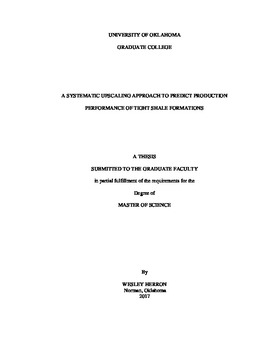| dc.description.abstract | This thesis presents a novel method to predict fluid flow in tight shale formations. Conventional Darcy models have proven valuable when working with conventional reservoirs, but cannot reliably relate microscopic dispersion behavior to field-scale production in tight shale formations. The aim of this paper is to provide an analytical method that allows for the effective upscaling of lab-scale results to the field-scale, and provides predictive power when working with additional wells in the same formation.
We develop a microscopic mathematical model relating core and formation fluid properties to resulting production curves. The underlying calculations for this new approach are based on the Fourier transform solution of the Heat Conduction Equation. The release of gas from solution, the different rates of dispersion between the gas and liquid phases, and the effects of both on the pressure of the system are considered. An iterative numerical method is used, with the results from the previous time step acting as the initial condition for the current time step’s Fourier solution, with boundary conditions being variable as bottom hole pressure data suggests. Underlying equations and assumptions are stated and explained. Results are compared and verified with a previously created macroscopic approach (Moghanloo et al, 2015).
A modeling tool using the above described microscopic method is developed for field applications. Production data from shale oil wells in the Niobrara formation are used to test and validate the simulation results. The advantages and limitations of this model are discussed, as well as the potential for further investigation and improvement.
The advantage of this method is that standard, readily available lab-scale data can be used to predict field production using analytical scaling techniques, allowing for effective and realistic predictions to be made of well performance, using standard engineering level computer hardware. | en_US |
